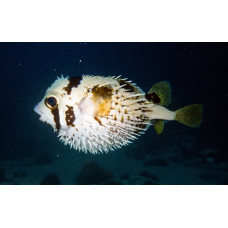Latin name
Diodon liturosus
Other name
Shortspine porcupinefish, blotched porcupinefish, brown-backed porcupinefish
Identification
The body of the Black-blotched porcupinefish is elongated with a spherical head and large, round, forward-projecting eyes. The body is covered with short spines. When threatened, the pufferfish inflates itself by taking in water, erecting its spines in all directions. The spines, as well as the liver, skin, and internal organs, contain the neurotoxin tetrodotoxin. It is a semi-aggressive fish and will perceive any fish smaller than itself as food.
Features of fish fins
Dorsal spines (total): 0; Dorsal soft rays (total): 14 - 16; Anal spines: 0; Anal soft rays: 14 - 16.
The pectoral fins are large, and pelvic fins are absent. The anal and dorsal fins are located close to the tail and move simultaneously during swimming.
Fish coloring
The body of these fish is a light sandy or light brown color. The fins are a uniform white or light yellow.
Distribution
They inhabit the tropical and subtropical waters of the Indo-Pacific region, from the eastern coast of Africa to Japan, the Society Islands, and Western Australia, as well as in the southeastern Atlantic Ocean off the coast of South Africa.
Habitat
Adults prefer lagoons, outer reef slopes, and seaward coral or rocky reefs at depths ranging from 1 to 90 m, but are most commonly found at depths of 15 to 30 m
Size
This is a medium-sized fish, reaching up to 65 cm (about 26 in) in length, but is commonly found at around 45 cm (about 18 in).
Behavior
Sometimes, a very small fish can be dangerous to a huge shark. If swallowed by a shark, the Black-blotched porcupinefish can use its sharp beak to bore through the shark's stomach and side to escape, killing the predator in the process.
Food and feeding habits
It is a carnivorous fish. Its diet consists primarily of sea urchins, gastropods, and crustaceans. In aquariums, it should be fed live and frozen meaty foods such as bloodworms, shrimp, and minced meat.
Reproduction
This fish is solitary, except during mating periods. It is nocturnal, with peak activity at dusk and dawn. During the day, it typically hides in caves or under ledges.
Fishing
This species has minor commercial importance. It is caught for the aquarium trade.
Relationship with humans
There are reports of ciguatera poisoning from this species. It is not typically sold for food.
| Classification | |
| Phylum | Chordata |
| Class | Actinopterygii |
| Squad | Tetraodontiformes |
| Family | Diodontidae |
| Genus | Diodon |
| Species | D. liturosus |
| Features | |
| Conservation status | Least Concern |
| Habitat | Pelagic |
| Life span, years | No information |
| Maximum body weight, kg | No information |
| Maximum length, cm | 65 |
| Sailing speed, m/s | No information |
| Threat to people | Not edible |
| Way of eating | Carnivorous |

